Sales of whey-plus-prebiotic stacks for RTD shakes in the Commonwealth of Independent States are estimated at USD 145 million in 2025, with projections indicating a rise to USD 358 million by 2035, reflecting a CAGR of approximately 9.4% over the forecast period. This growth reflects both a broadening consumer base and increased per capita consumption in key urban centers.
The rise in demand is linked to shifting dietary preferences, growing awareness of gut health benefits, and evolving fitness trends. By 2025, per capita consumption in leading CIS countries such as Russia, Kazakhstan, and Ukraine averages between 0.8 to 1.2 kilograms, with projections reaching 1.6 kilograms by 2035. (Disclaimer: For the purpose of this report, Ukraine has been kept in CIS). Moscow leads among metropolitan areas, expected to generate USD 89 million in whey-plus-prebiotic RTD shake sales by 2035, followed by St. Petersburg (USD 31 million), Almaty (USD 24 million), Kyiv (USD 19 million), and Minsk (USD 14 million).
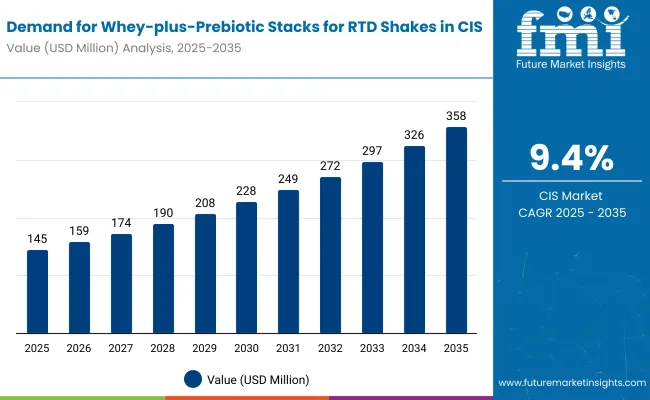
The largest contribution to demand continues to come from whey isolate-based formulations, which are expected to account for 62% of total sales in 2025, owing to superior bioavailability, faster absorption rates, and fitness community preference. By distribution channel, fitness specialty stores represent the dominant retail format, responsible for 47% of all sales, while online platforms and pharmacy chains are expanding rapidly.
Consumer adoption is particularly concentrated among young fitness enthusiasts and health-conscious millennials, with income and urban density emerging as significant drivers of demand. While price remains a limiting factor, the average price premium over conventional protein shakes has declined from 28% in 2020 to 19% in 2025. Continued improvements in manufacturing scale and private label offerings are expected to accelerate affordability and access across mid-income households. Regional disparities persist, but per capita demand in high-growth Central Asian cities is narrowing the gap with traditionally strong Russian urban hubs.
The whey-plus-prebiotic stacks segment for RTD shakes in the CIS is classified across several segments. By protein concentration, the key categories include whey isolate blends, whey concentrate formulations, hydrolyzed whey combinations, and casein-whey hybrids. By distribution channel, the segment spans fitness specialty stores, online platforms and direct-to-consumer sites, pharmacy chains, supermarkets and hypermarkets, and sports nutrition clubs.
By prebiotic source, formulations include inulin-based blends, oligofructose combinations, galacto-oligosaccharides, resistant starch compounds, and Multi-oligosaccharide complexes. By consumer profile, the segment covers fitness enthusiasts and bodybuilders, health-conscious millennials, post-workout recovery seekers, digestive health focused consumers, and professional athletes.
By region, countries such as Russia, Kazakhstan, Ukraine, Belarus, and Uzbekistan are included, along with coverage across all CIS member states. By city, key metro areas analyzed include Moscow, St. Petersburg, Almaty, Kyiv, and Minsk.
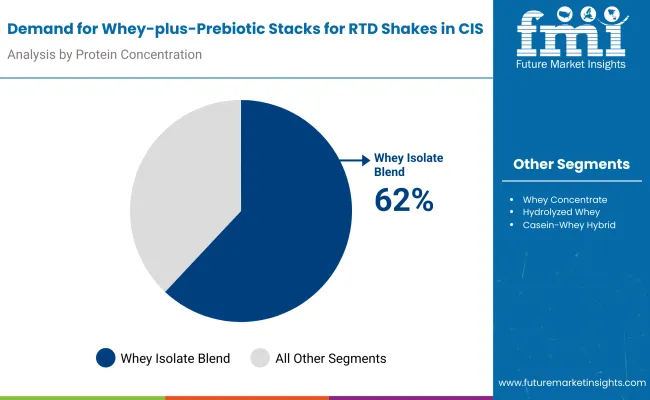
Whey isolate blends are projected to dominate sales in 2025, supported by superior purity levels, minimal lactose content, and fast absorption characteristics. Other formulations such as concentrate, hydrolyzed, and hybrid blends are growing steadily, each serving distinct nutritional and digestive needs.
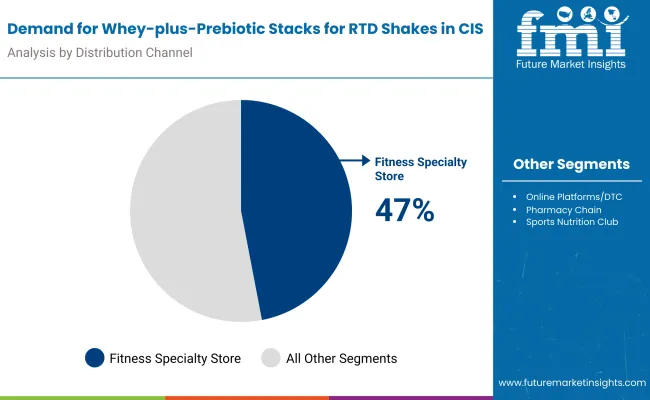
Whey-plus-prebiotic stacks for RTD shakes in the CIS are distributed through a mix of specialized fitness retail and mainstream health channels. Fitness specialty stores are expected to remain the primary point of sale in 2025, followed by online platforms and pharmacy chains. Distribution strategies are evolving to match consumer shopping behavior, with growth coming from both physical and digital formats.
Whey-plus-prebiotic stacks for RTD shakes in the CIS utilize various prebiotic compounds, selected for digestive compatibility, stability in liquid formats, and synergistic effects with protein absorption. Inulin remains the most widely used prebiotic input, though alternatives like oligofructose and galacto-oligosaccharides are gaining momentum. Product developers are increasingly exploring multi-strain and targeted prebiotic complexes to meet evolving gut health and performance demands.
The whey-plus-prebiotic stacks category appeals to a diverse consumer base across age groups, fitness levels, and health priorities. While motivations vary from performance enhancement to digestive wellness to convenient nutrition, demand is concentrated among five key demographic clusters. Each group brings distinct purchase behaviors, channel preferences, and product expectations.
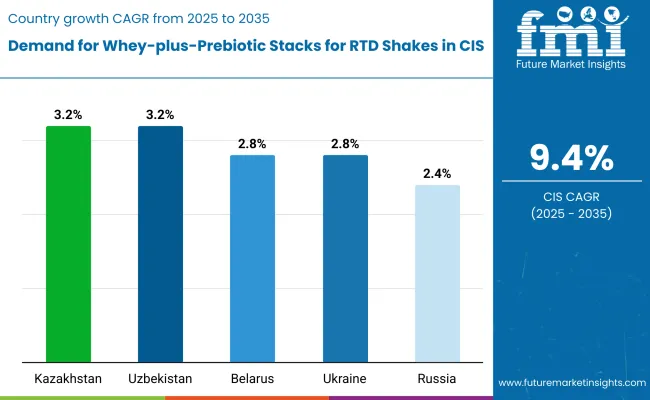
Whey-plus-prebiotic stack sales will not grow uniformly across every metro area. Rising fitness culture adoption and faster per-capita spending growth in Central Asian hubs give Almaty a measurable edge, while mature Russian centers such as Moscow expand more steadily from a higher base. The table below shows the compound annual growth rate (CAGR) each of the five largest cities is expected to record between 2025 and 2035.
| City | CAGR (2025 to 2035) |
|---|---|
| Almaty | 3.8% |
| Kyiv | 3.8% |
| Minsk | 3.2% |
| St. Petersburg | 3.2% |
| Moscow | 2.9% |
Between 2025 and 2035, demand for whey-plus-prebiotic stacks for RTD shakes is projected to expand across all major CIS metropolitan areas, but the pace of growth will vary based on fitness culture development, retail penetration, and baseline consumption levels. Among the top five cities analyzed, Almaty and Kyiv are expected to register the fastest compound annual growth rate (CAGR) of 3.8%, outpacing more established Russian fitness hubs. This acceleration is underpinned by rapidly expanding gym networks, growing sports nutrition awareness, and increasing availability of premium formulations across specialty fitness stores and online platforms. In both cities, per capita consumption is projected to rise from 0.9 kg in 2025 to 1.4 kg by 2035, closing the gap with higher-consumption cities such as Moscow and St. Petersburg. Retail assortment is also expanding faster in these regions, with new isolate-based and multi-prebiotic formats gaining traction in fitness centers and health-focused retailers.
Minsk and St. Petersburg are each forecast to grow at a CAGR of 3.2% over the same period. Both cities already maintain established fitness retail ecosystems, with widespread access to whey-plus-prebiotic formulations in specialty stores, pharmacy chains, and online platforms. In St. Petersburg, growth is supported by a strong fitness community, brand experimentation, and increasing uptake of premium isolate formulations. Minsk reflects similar dynamics, particularly among young professionals and fitness-conscious consumers seeking convenient nutrition solutions. In both cities, per capita consumption is projected to increase from 1.1 kg in 2025 to 1.6 kg by 2035, reflecting mainstreaming of specialized sports nutrition products.
Moscow, while maintaining the highest overall sales in absolute terms, is expected to grow at a CAGR of 2.9%, slightly below its regional counterparts. The city already exhibits higher-than-average per capita intake (1.3 kg in 2025), extensive product saturation, and a dense fitness retail network. Growth will likely come from premium product adoption, new prebiotic formulation launches, and increased consumption frequency rather than first-time trial.
Collectively, these five metro areas represent the core of urban demand for whey-plus-prebiotic stacks in the CIS, but their individual growth paths highlight the importance of regional tailoring in product positioning, pricing strategies, and channel development.
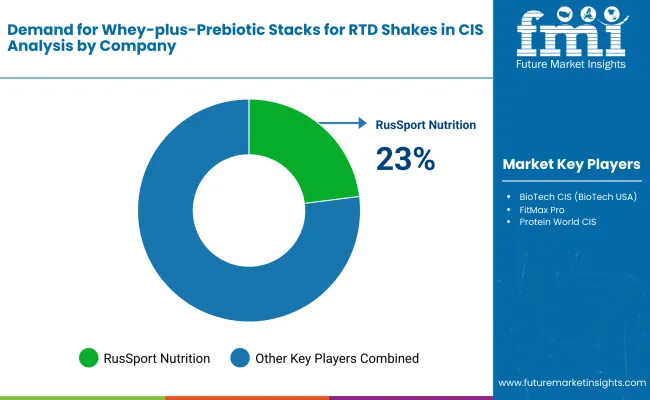
The competitive environment is characterized by a mix of established international sports nutrition brands and emerging regional specialists. Distribution breadth through fitness channels rather than product variety remains the decisive success factor: the five largest suppliers collectively reach more than 8,000 fitness retail outlets across the CIS and account for a majority of specialty store shelf facings in the category.
RusSport Nutrition is the most established regional participant. The company offers more than 45 whey-based SKUs, with prebiotic-enhanced formulations representing 30% of its portfolio. Its core range of isolate blends and recovery formulas gives it deep penetration in Russian fitness specialty stores while maintaining growing presence in Kazakhstan and Belarus markets.
BioTech CIS, the regional arm of BioTech USA, leverages European formulation expertise and established supply chains to place premium whey-plus-prebiotic combinations in mainstream fitness stores and pharmacy chains. Post-expansion investments in local production have allowed BioTech to introduce competitively-priced isolate formulations near parity with concentrate-based alternatives, reinforcing its role as a bridge between international quality and regional accessibility.
FitMax Pro, owned by a regional investment group, benefits from partnerships with major CIS gym chains and co-marketing with fitness equipment suppliers. Recent launches under the Gut-Fit Performance sub-brand extend FitMax beyond basic protein into targeted digestive health formulations expressly targeting the recovery-focused fitness consumer.
The next tier comprises international entrants and specialist companies. Protein World CIS focuses on premium isolate-prebiotic combinations and direct-to-consumer sales; recent financial disclosures showed quarterly sales of USD 8.2 million, signaling regional but still developing scale. , now expanding beyond its home market after successful domestic growth, adds locally-sourced prebiotic ingredients and culturally-relevant flavor profiles to appeal to Central Asian fitness communities.
Private-label programs at major fitness chains and specialty retailers are widening assortment at price points 15-20% below branded equivalents, putting margin pressure on smaller suppliers while supporting category adoption. Consolidation is therefore likely to continue as manufacturing scale and multi-country distribution become critical for maintaining shelf visibility and promotional frequency in this rapidly evolving category.
| Attribute | Details |
|---|---|
| Study Coverage | CIS sales and consumption of whey-plus-prebiotic stacks for RTD shakes from 2020 to 2035 |
| Base Year | 2025 |
| Historical Data | 2020 |
| Forecast Period | 2025 to 2035 |
| Units of Measurement | USD (sales), Metric Tonnes (volume), Kilograms per capita (consumption) |
| Geography Covered | All CIS member states; country-level and city-level granularity |
| Top Countries Analyzed | Russia, Kazakhstan, Ukraine, Belarus, Uzbekistan |
| Top Cities Analyzed | Moscow, St. Petersburg, Almaty, Kyiv , Minsk |
| By Protein Concentration | Whey isolate blends, Whey concentrate formulations, Hydrolyzed whey combinations, Casein-whey hybrids |
| By Distribution Channel | Fitness specialty stores, Online platforms/DTC, Pharmacy chains, Supermarkets, Sports nutrition clubs |
| By Prebiotic Source | Inulin-based blends, Oligofructose , Galacto -oligosaccharides, Resistant starch, Multi-strain complexes |
| By Consumer Profile | Fitness enthusiasts, Health-conscious millennials, Recovery seekers, Digestive health focused, Professional athletes |
| Metrics Provided | Sales (USD), Volume (MT), Per capita consumption (kg), CAGR (2025 to 2035), Share by segment |
| Price Analysis | Average unit prices by protein concentration and region |
| Competitive Landscape | Company profiles, private label strategies, fitness channel presence, regional vs. international |
| Forecast Drivers | Per capita spending trends, fitness culture expansion, health awareness, urban population growth |
By 2035, total CIS sales of whey-plus-prebiotic stacks for RTD shakes are projected to reach USD 358 million, up from USD 145 million in 2025, reflecting a CAGR of approximately 9.4%.
Whey isolate blends hold the leading share, accounting for approximately 62% of total sales in 2025, followed by whey concentrate formulations and hydrolyzed combinations.
Almaty and Kyiv lead in projected growth, each registering a CAGR of 3.8% between 2025 and 2035, due to expanding fitness culture and growing sports nutrition awareness.
Fitness specialty stores are the dominant sales channel (47% share in 2025), but online platforms and pharmacy chains are growing at double-digit CAGR, especially in urban regions.
Major players include RusSport Nutrition, BioTech USA, FitMax, Gym Pro Nutrition, Fitness Formula CIS, Ultimate Nutrition CIS with growing competition from fitness chain private labels and international entrants.






Our Research Products

The "Full Research Suite" delivers actionable market intel, deep dives on markets or technologies, so clients act faster, cut risk, and unlock growth.

The Leaderboard benchmarks and ranks top vendors, classifying them as Established Leaders, Leading Challengers, or Disruptors & Challengers.

Locates where complements amplify value and substitutes erode it, forecasting net impact by horizon

We deliver granular, decision-grade intel: market sizing, 5-year forecasts, pricing, adoption, usage, revenue, and operational KPIs—plus competitor tracking, regulation, and value chains—across 60 countries broadly.

Spot the shifts before they hit your P&L. We track inflection points, adoption curves, pricing moves, and ecosystem plays to show where demand is heading, why it is changing, and what to do next across high-growth markets and disruptive tech

Real-time reads of user behavior. We track shifting priorities, perceptions of today’s and next-gen services, and provider experience, then pace how fast tech moves from trial to adoption, blending buyer, consumer, and channel inputs with social signals (#WhySwitch, #UX).

Partner with our analyst team to build a custom report designed around your business priorities. From analysing market trends to assessing competitors or crafting bespoke datasets, we tailor insights to your needs.
Supplier Intelligence
Discovery & Profiling
Capacity & Footprint
Performance & Risk
Compliance & Governance
Commercial Readiness
Who Supplies Whom
Scorecards & Shortlists
Playbooks & Docs
Category Intelligence
Definition & Scope
Demand & Use Cases
Cost Drivers
Market Structure
Supply Chain Map
Trade & Policy
Operating Norms
Deliverables
Buyer Intelligence
Account Basics
Spend & Scope
Procurement Model
Vendor Requirements
Terms & Policies
Entry Strategy
Pain Points & Triggers
Outputs
Pricing Analysis
Benchmarks
Trends
Should-Cost
Indexation
Landed Cost
Commercial Terms
Deliverables
Brand Analysis
Positioning & Value Prop
Share & Presence
Customer Evidence
Go-to-Market
Digital & Reputation
Compliance & Trust
KPIs & Gaps
Outputs
Full Research Suite comprises of:
Market outlook & trends analysis
Interviews & case studies
Strategic recommendations
Vendor profiles & capabilities analysis
5-year forecasts
8 regions and 60+ country-level data splits
Market segment data splits
12 months of continuous data updates
DELIVERED AS:
PDF EXCEL ONLINE
Demand for RTD Whey Deployments for Shelf-stable Drinks in CIS Size and Share Forecast Outlook 2025 to 2035
RTD Coffee Market Size and Share Forecast Outlook 2025 to 2035
RTD Cocktail Market Analysis - Size, Share, and Forecast Outlook 2025 to 2035
CIS Insulin Market Size and Share Forecast Outlook 2025 to 2035
RTD Bottled Cocktail Market - Size, Share, and Forecast Outlook 2025 to 2035
RTD Canned Cocktail Market Growth - Convenience & Mixology Trends 2025 to 2035
RTD Temperature Sensors Market Growth - Trends & Forecast 2025 to 2035
Cissus Quadrangularis Market Analysis by Product Form, Grade, End Use and Sales Channel Through 2035
RTD Cocktail Shots Market Analysis by Type, Packaging Type, and Distribution Channel Through 2035
Scissor Lift Market Size and Share Forecast Outlook 2025 to 2035
Decision Intelligence Market Forecast and Outlook 2025 to 2035
Decision Management Applications Market Size and Share Forecast Outlook 2025 to 2035
Precision Livestock Farming Market Size and Share Forecast Outlook 2025 to 2035
Precision Wire Drawing Service Market Size and Share Forecast Outlook 2025 to 2035
Precision Planting Market Size and Share Forecast Outlook 2025 to 2035
Precision Bearing Market Size and Share Forecast Outlook 2025 to 2035
Precision Laser Engraving Machines Market Size and Share Forecast Outlook 2025 to 2035
Precision Analog Potentiometer Market Size and Share Forecast Outlook 2025 to 2035
Precision Blanking Dies Market Size and Share Forecast Outlook 2025 to 2035
Precision Components And Tooling Systems Market Size and Share Forecast Outlook 2025 to 2035

Thank you!
You will receive an email from our Business Development Manager. Please be sure to check your SPAM/JUNK folder too.
Chat With
MaRIA